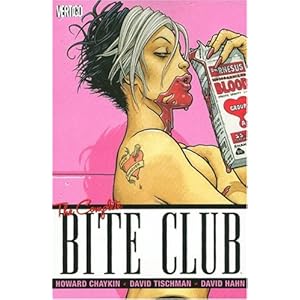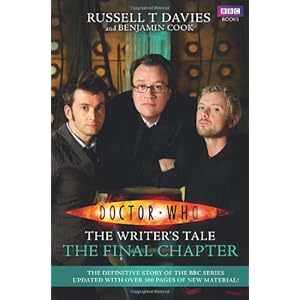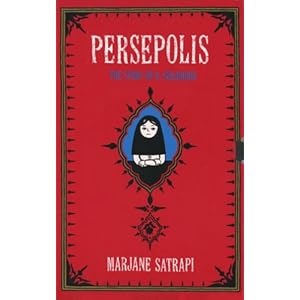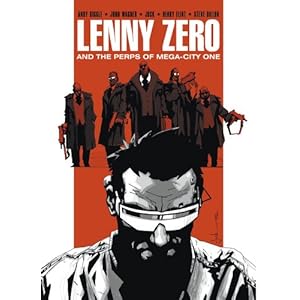
There might be two ways to look at this book, but the question of why in the world I own it should probably be raised. When I lived in Athens in the late 1990s, I would occasionally visit the J&J Flea Market a little north of town. There, one vendor had a very impressive room full of very inexpensive comics. Most of them were three-for-a-dollar and probably worth even less, but he also had several boxes of more entertaining 1970s books - Superman Family, Metal Men and the like - for not more than two bucks each. Occasionally, a trade paperback or graphic novel would slip in for the same very low price, and I would usually snap it up, thinking $1 a quite fair price to sample a very long story from comics with which I was unfamiliar.
I also suffered from that foolish malady common to collectors where I wished to have shelves full of books. The quality could come later; first, I wanted the shelves to look impressive and full. This sometimes meant that I would spend an occasional dollar or two on books that I normally would not, just to swell the shelves. You know the greatest thing about swearing off the bloat of my material world a year and a bit ago? I'm no longer tempted by dumb things like that.
At any rate, I suspected that I wouldn't enjoy the book, and I was proved right. I disliked it from the start, as the designer evidently chose to blow his budget on a long lunch. The very first page of the book is the first page of story, and it opens very abruptly, without any kind of scene-setting or even credits. Parsing out who wrote and drew what, and where this material originally appeared, is like a jigsaw puzzle. On the inside back cover(!), there's a list of comics where these chapters were originally serialized. I count twelve, but there are thrteen chapters inside. The twelfth episode is labeled "part ten." The original covers of these twelve comics are reproduced at the size of postage stamps. Alan Grant is credited as one of the five writers on the inside front cover, but because some of the interior credits are edited out, I'm unable to tell what pages he actually scripted.
In other words, this is yet another slapped-together, thought-free, half-assed cash-in to rip off as many Batman readers as can be suckered in by it. Having said that, it is certainly possible that the $19.99 edition presently in print might have addressed some of this volume's deficiency. That is, after all, a price 50% greater than the $12.95 that DC originally charged for this book. We know that DC is capable of so much better - see their astounding series of Starman Omnibus volumes - and so it's just pathetic seeing how they can just crap out books with the barest minimum of work and get away with it.
But really, all the tinkering in the world couldn't turn these comics into anything readable. DC, like its principal rival, often creates "crossover" stories which wind their way through several loosely-related titles over the course of a couple of months. Indeed, "Contagion" was a management-decreed storyline, mostly (apparently) written by Chuck Dixon, and given to the comics' regular creative teams to tell. For my readers unfamiliar with this practice, it would mean that on one week, you could read part one of the story in Batman # 529, and parts two and three the following week in Catwoman # 31 and in Azrael # 15, and so on. There is, bluntly, no way in the universe that this could ever result in a satisfying read for anybody. It never has worked, and it never will. The closest that it has ever come was in a Grant Morrison-led crossover called One Million, and that worked because DC suspended its normal operations for a single month and let the story, as directed by Morrison, take over its entire line through individually-labeled and designed titles, and even that epic was fraught with pointless, unnecessary moments and melodramas that fell on their faces.
Well, maybe it worked somewhere else. Sometime soon, I'll try looking at a similar Superman crossover event from the period and see how well it reads.
This time out, the five writers attempt to tell a story where a lethal, no-known-cure plague called The Clench is brought to Gotham City and many of the city's wealthiest are trapped with it in a luxury high-rise. They send word to the city's underworld that they will pay five million for a cure, leading Robin, Catwoman and a bounty hunter in a race to find one of the only known survivors of the disease. Meanwhile, Batman, Huntress and Nightwing try to keep order in the city after the Clench escapes into the population, and the untrustworthy Poison Ivy, who is immune to all diseases, is recruited to help.
The patchwork story, with its artificial cliffhangers, just does not engage in any way. Dixon's installments are the most energetic, and Denny O'Neil's the most somber and humorless. At one point, Robin starts to succumb to the Clench, leaving no doubt as to how quickly this plague will be cured. Unresolved subplots from these books wander through and just confused me. Commissioner Gordon has been outed from his job when the book opens, and his replacement is a dim buffoon. The Clench has evidently been dumped into the population, deliberately, by a gang of Azrael's old enemies. I'm sorry to spoil that, but telling you that the rogues' gallery of an already-forgotten C-list supporting character is behind this allegedly important story might best explain why this book is not recommended at all.





